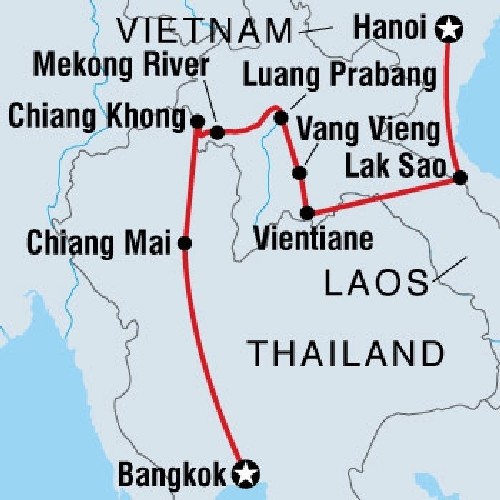Thailand is gearing up to implement an Electronic Travel Authorization (ETA) system for visitors from visa-free countries, following in the footsteps of international systems like the USA’s Electronic System for Travel Authorization (ESTA), and the proposed European Travel Information and Authorization System (ETIAS), set to come into effect in 2025.
The system will allow authorities to pre-screen visa-exempt travelers before they arrive.
The purpose of this move is to improve the monitoring and screening of foreign nationals entering Thailand, while ensuring the nation’s safety and security.
The system aims to improve border control, identify potential security risks, and facilitate smoother travel into Thailand.
Key Details of Thailand’s ETA
Who Will Be Affected?
The ETA will be applicable to nationals of 93 countries that currently enjoy visa-free entry into Thailand. This includes travelers from Australia, New Zealand, China, Russia, the United States, and the United Kingdom.
The ETA will be compulsory for visa exempt foreign nationals each time prior to entering Thailand by air, land, or sea.
Diplomats are exempt from the ETA. There is currently no exemption for any other group.
Timeline of Implementation
The ETA system was scheduled to begin its pilot phase in December 2024, with full implementation planned for June 2025. However, as I predicted, the pilot phase has been postponed until further notice.
The successful launch of such systems typically depends on seamless integration with a variety of third-party platforms, including airlines, travel agencies, and government agencies. This can lead to unforeseen technical or logistical challenges. For instance, Europe's ETIAS (European Travel Information and Authorisation System) faced similar setbacks and has already been postponed once.
Got Travel Medical Insurance Yet?
I highly recommend SafetyWing. Their affordable, flexible plans are ideal for travelers, digital nomads, and holiday-makers, with low pricing and excellent customer service. Most importantly, the claims process is straightforward and hassle-free. I personally use SafetyWing to cover all my trips.
How It Works
Applications for the ETA will be made online through Thailand’s official e-Visa platform.
Unlike some countries where similar programs allow for multiple entries over a period of time, Thailand’s ETA will require approval for each individual trip. However, apparently travelers will benefit from expedited entry through automated passport gates once their ETA is approved.
Once approved, applicants will receive an ETA authorization via email, which includes a QR code granting access through electronic immigration gates.
The system will automatically verify passport authenticity, check for any criminal history or disruptive behavior in Thailand, and scan relevant Interpol notices. These checks are identical to those conducted by immigration officers at airports and border crossings, but the ETA process eliminates delays and potential disputes, streamlining entry.
ETA Cost
Though complete details regarding the process are still forthcoming, the ETA is expected to be free of charge, offering convenience without additional costs.
Requirements
While the Ministry of Foreign Affairs has yet to release the full details, requirements are likely to include the basics such as proof of accommodation and onward travel.
While the ETA seems like more unnecessary red tape, such schemes are becoming more common, as global security and surveillance is stepped up. Indeed, a similar system is already in place in Malaysia and, to some extent, Cambodia.
Entry Restrictions
It is unknown whether the system will impose limits on the number of 60-day entries allowed in a given year. Until July, Thai immigration restricted visa-free entries to two border trips per year, a rule that has since been lifted. However, the ETA could reintroduce such restrictions, with the system issuing computerized rejections rather than being rejected or told that this is your last entry when you arrive.
Thailand’s Expanding Visa Policies
The launch of the ETA is just one component of Thailand’s evolving visa landscape. The government has been actively updating visa regulations to accommodate a wider range of travelers, including professionals, digital nomads, and freelancers.
One of the most notable changes is the introduction of the five-year “Destination Thailand Visa” (DTV). This visa, aimed at remote workers and digital nomads, allows multiple entries over five years with stays of up to 180 days per visit, catering to the needs of the modern workforce.
Extended Visa-Free Stays
In addition to the ETA, Thailand has extended visa-free stays from 30 to 60 days, with the option to apply for a further 30-day extension. The visa exemption and visa-on-arrival lists have also been expanded, simplifying travel for more nationalities.
Tips for a Better Life in Thailand
Get Good Health Insurance:
Start with a quick quote here from Cigna. Then you can compare it to other companies.
Send Money to Thailand:
If you are sending money to your loved one, or your own Thai bank account, try Wise here. It is fast and cheap. Me and the majority of my readers are using it.
Improve Your Thai Skills:
Learning Thai makes life easier, and way more fun. I use Thaipod101. Get a free account by clicking here. It is really easy to use.
Last Updated on



JamesE says
Mar 31, 2025 at 10:09 pm
Eric says
Sep 28, 2024 at 8:28 am
TheThailandLife says
Sep 29, 2024 at 2:12 am
JamesE says
https://www.theverge.com/2023/6/14/23759585/odni-spy-report-surveillance-data-location-tracking
Another situation showing how little we know what goes into the sausage...
Sep 23, 2024 at 10:20 pm
JamesE says
Sep 20, 2024 at 10:18 pm
TheThailandLife says
Sep 23, 2024 at 8:12 pm
Robert says
Mar 29, 2025 at 9:40 pm